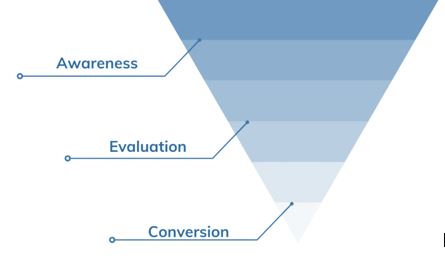Funnel in SEO : from Awareness to conversion
Talking about Funnel in SEO is not to be neglected. According to the marketing funnel, before someone is ready to buy, they have to evaluate their options. And before they evaluate their options, they have to become aware of their need and the products or services that could fill it.
It is called a funnel because to get to the bottom, you have to start at the top and make your way down. Success at one step is dependent on the previous steps. As you have noticed, we talk about funnel in SEO as well. Not be confused with funnels provided by the free Google Analytics software, but is somewhat similar.
Seo and the funnel
The role of SEO is, in short, to bring or increase traffic by putting action in place to improve visibility. In the meantime, it is important to realise that not all keywords or content published have the same effect. Some visitors are searching with the intention to purchase, others are looking for more information for general knowledge. Others are ready to convert, while others need more encouragement.
This is the reason why you may notice a lot of movement on your site but few registrations. There is then a need to understand the funnel in an SEO approach.
The importance of the funnel in SEO
A funnel is used to track the steps that lead up to a conversion (intended action). Using a funnel report helps you see where people are dropping off on the path to conversion.
For example, E-commerce companies want people to buy products on their site. Their funnel may involve these few steps:
- Visited site
- Viewed product
- Placed product in cart
- Purchased
The funnel steps
The funnel reveals the customer’s journey which involves: Awareness, Evaluation and Conversion. Funnel steps can differ from one industry to another.
Most users will visit your site at the awareness stage. Then you will notice a decrease in the number as they proceed to the intended action (conversion stage).
Reconsidering how you use SEO to manage your site at each stage of the funnel may help move those visitors from the awareness stage to taking action.

The funnel steps: Awareness
This is the stage where your customer is looking for information regarding a certain question or product they want to purchase. They are not quite sure of which game they want to play or platform they want to go to.
On the side of the SEO expert, this is the step where search engines need to discover and crawl your created content. You need to submit your site to Google for indexing so your pages can rank and get clicks. You need to deliver content that’s geared around the type of search queries that are asked at this early stage. Also, optimizing your site for customers at the awareness stage involves:
- Uncovering keywords with the right search volume
- Using tools and SEO techniques to get keywords
- Competitor analysis
The funnel steps: Evaluation
At this stage, the customer is really serious about taking an action. They just haven’t decided exactly what they’re going to buy or who they’re going to buy it from. They have definitely seen your content and offer, but need some push and want to see different options in order to decide.
On the side of the SEO expert, this the step could mean:
- Writing blog posts that target relevant search terms
- Optimizing existing landing pages to capture a wider variety of phrases
- Checking keyword usage
- Call to action
- Incorporating FAQs (Blogs that bring traffic
- Infographics, newsletters (some industry)
- Guest blogging (affiliate)
- Think about user experience
The funnel steps: Conversion
This is sometimes considered as the most difficult and uncertain step. After you created the content, built the traffic, you will still don’t know if the customer will really take action.
According to Neil Patel, “At this stage, keyword tools become, to some extent, less important.” People in the awareness stage know you exist and may have visited your site a million times. Now you have to do few things, according to your industry, to convince them to buy what you are selling.
Persuading them could involve:
- Create new content for questions which haven’t yet been answered
- Make existing questions visible (featured snippet)
- Use reviews or testimonials
- Check competitors and adapt your content accordingly, but better (instead of written testimonies, use videos)
- Monitor user behaviour on key pages
- Make sure your internal linking is on point
- Don’t underestimate link building
- Conduct buyer follow up
- Email outreach
- Give out rewards
- Better your customer service


